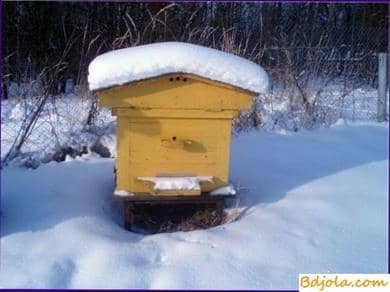Bees in the open air

Bees hibernate in the apiary, in their usual places. Whenever there are stable colds, the beekeepers open the tapes for the entire lumen. The value of the tap does not affect the temperature in the hive. As with a small, and with a large tap, it almost does not differ from the outside. However, with a large gap, the danger of plugging the tap with dead shoulders is excluded, dampness does not accumulate either in the corners or in the sides of the hive, as is the case with poor ventilation. Dry cold air enters the hive from below and leaves into the upper duct and the ceiling.
The air in the bee house moves very slowly, drafts are not formed due to the honeycombs and the warmth cushion. The club of bees is not purged, as it were, by a weak current of air, in a multi-hull beehive, the opening is 20 mm high. To the bottom of the tap is a barrier from the mice. Make it from a two-millimeter wire that passes through the entire slot and horizontally divides it in half.
To prevent the snow from hammering, the wooden shields are inclined to the front walls of the hives in their entire width. They protect the tapewings as well from the wind. Do not disturb the bees and birds. The snow gradually falls asleep hives. Where there is not enough rainfall, it is not necessary to fill them with snow. The bees themselves do not need it. They feel good and without snow cover. In severe frosts, the upper flap is closed with an inise stopper. It slows down ventilation. In the second half of the winter, when the club rises to the top of the nest, the bees can be seen through the upper chute and listen. By sound it’s easy to determine how the bees winter.
In open steppe areas, where strong winds blow in the winter, each hive is wrapped with tar from the sides and behind. A piece of roofing furring to the roof is tied to the beehive from above and below. The front wall remains open. It can be covered
The black color of the shirt absorbs the sun’s heat, contributes to the warming of the hive and the flight of bees in late autumn and early spring, and in the thaw in winter. The winter club can expand and change position, move upwards or even backwards, to honey. The sun exposure, promoted by the dark hive clothing, is useful for bees in winter.
In the hollows, the dark bark of trees serves as a beacon for the sun’s heat.
Families who spend the winter in the open air do not need any special care. When the spring comes, the snow from the front walls of the hives is thrown away so that it does not interfere with the flight of the bees, shields are removed. Now bees can take advantage of a warm day to fly around.
Bees in the open air
